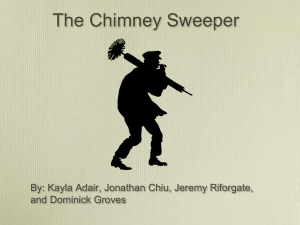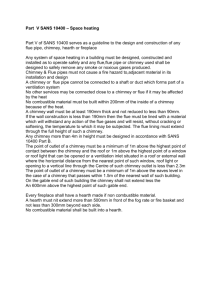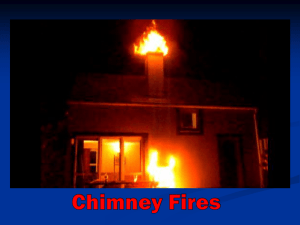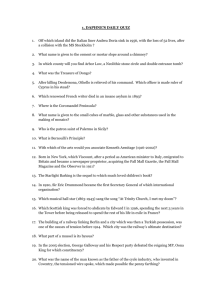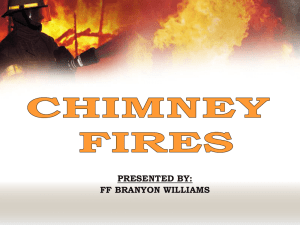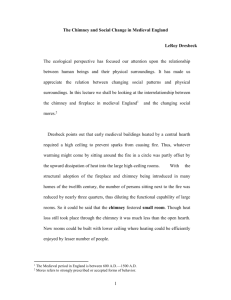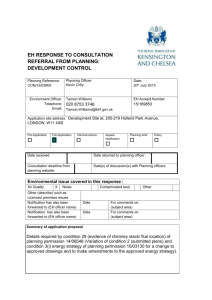Chimney stack removal guide
advertisement
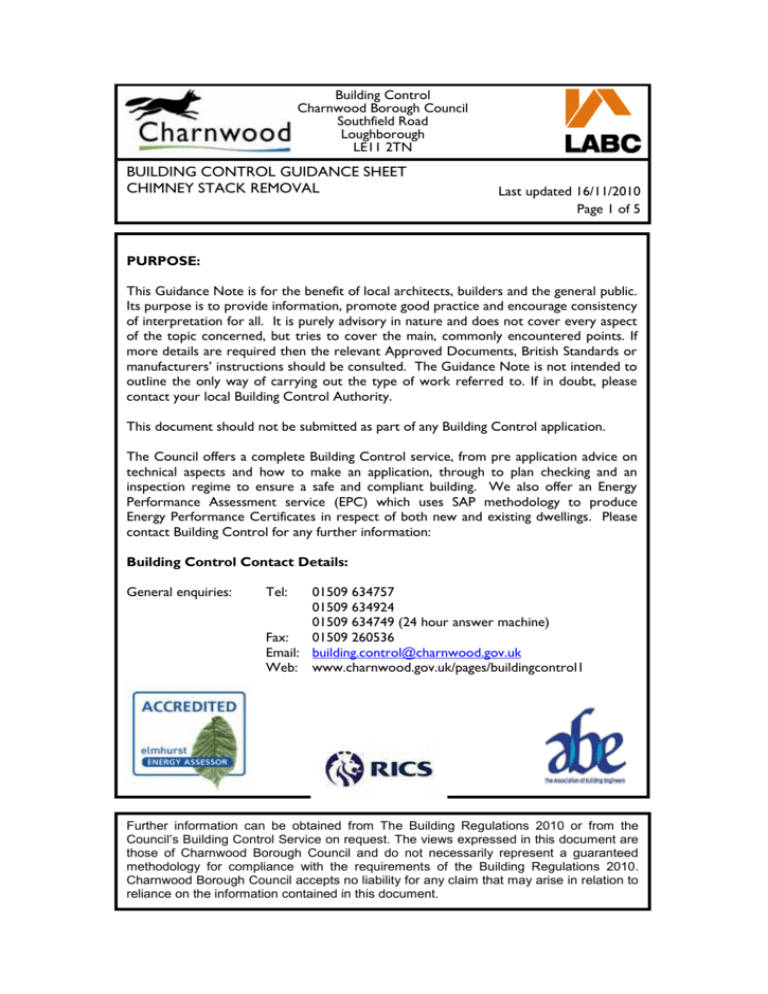
Building Control Charnwood Borough Council Southfield Road Loughborough LE11 2TN BUILDING CONTROL GUIDANCE SHEET CHIMNEY STACK REMOVAL Last updated 16/11/2010 Page 1 of 5 PURPOSE: This Guidance Note is for the benefit of local architects, builders and the general public. Its purpose is to provide information, promote good practice and encourage consistency of interpretation for all. It is purely advisory in nature and does not cover every aspect of the topic concerned, but tries to cover the main, commonly encountered points. If more details are required then the relevant Approved Documents, British Standards or manufacturers’ instructions should be consulted. The Guidance Note is not intended to outline the only way of carrying out the type of work referred to. If in doubt, please contact your local Building Control Authority. This document should not be submitted as part of any Building Control application. The Council offers a complete Building Control service, from pre application advice on technical aspects and how to make an application, through to plan checking and an inspection regime to ensure a safe and compliant building. We also offer an Energy Performance Assessment service (EPC) which uses SAP methodology to produce Energy Performance Certificates in respect of both new and existing dwellings. Please contact Building Control for any further information: Building Control Contact Details: General enquiries: Tel: 01509 634757 01509 634924 01509 634749 (24 hour answer machine) Fax: 01509 260536 Email: building.control@charnwood.gov.uk Web: www.charnwood.gov.uk/pages/buildingcontrol1 Further information can be obtained from The Building Regulations 2010 or from the Council’s Building Control Service on request. The views expressed in this document are those of Charnwood Borough Council and do not necessarily represent a guaranteed methodology for compliance with the requirements of the Building Regulations 2010. Charnwood Borough Council accepts no liability for any claim that may arise in relation to reliance on the information contained in this document. 1. INTRODUCTION 1.1. The Building Regulations require that buildings remain structurally stable after alterations have been carried out on them. The removal of part or all of a chimney stack will require Building Regulation approval and work will need to be done to ensure the remaining part of the stack is properly supported. 1.2. The work must comply with the Building Regulations and an application to Building Control is required. 1.3. If a ground floor chimney breast is removed and suitable beams are not provided to carry the weight of the stack and chimney breast on the first floor the resulting eccentric loading of the stack and breast could eventually pull the wall over. 1.4. NOTE: Some chimneys act as a buttress and provide support to long walls. If this is the case consult a structural engineer. The engineers design will need to be submitted to Building Control prior to commencement. 1.5. If the chimney you are intending to remove is on a shared wall with your neighbour (the party wall) you will most likely have duties and obligations under the Party Wall Act 1996. This is designed to resolve disputes, which may arise, between neighbours when building work is carried out. The Party Wall Act is not administered by Building Control is available at http://www.communities.gov.uk/publications/planningandbuilding/partywall 2. REMOVING A CHIMNEY 2.1. To remove a chimney breast at ground or first floor you must first support the chimney adequately. The stack must be properly supported and the gallows bracket illustrated below is only one way. 2.2. Gallows Bracket - The use of gallows brackets is only permitted if: a) The stack is not completely vertical (i.e. a gathered flue to a central stack) b) The neighbours chimney breast on the other side of the party wall has not been removed (if it has then the whole of the chimney above the roof should be removed and the roof made good, *planning permission may be required*) c) The party wall supporting the gallows bracket is a minimum of 215mm thick, in brickwork, and in sound condition. d) The maximum width of the chimney breast for three brackets (and 6no M10 expanding bolts) to support is 1200mm, and two flues. For wider chimney breast a structural engineer should be consulted. e) The depth (projection) of the chimney breast is no more than 340mm f) The chimney is in a house no more than two storeys g) The relevant notices required under the Party Wall Act have been served on the adjoining owner (where the chimney is on a party wall). 2 3. CONSIDERATIONS 3.1. All members forming the brackets to be 75mm x 75mm x 6mm mild steel angles with 6mm fillet shop welded joints. Angles to be pre-drilled to take a minimum of 2no M12 chemical or resin anchor bolts. (e.g. Chemfix) 3.2. The bolts are to be drilled into sound brickwork, not mortar joints. 3.3. A plate (e.g. 10mm steel plate) should be placed on the top of the brackets to prevent soot and debris falling from the remaining chimney. 3.4. The minimum height of the chimney breast remaining within the house (below the roof line) must be equal to or greater than the height of brickwork in the stack above the roof. 3.5. To ensure rain and condensation coming down the flue is dried out by natural convection; the chimney pot should be capped with a ventilated cowl and insertion of an air brick at lower level. 3.6. Any concrete fireplace hearth at first floor level should be removed. Additional timber joists must be installed and adequately supported by the existing trimming joists. 3 If gallows brackets cannot be installed then a steel beam design will have to be considered – consult with your structural engineer to determine the design of the steel to be installed. 4. INSERTION OF STEEL BEAM(s) 4.1. Where the conditions are not suitable for a gallows bracket (see item 1 above) then the use of a structural steel beam or beam and posts may be required. This will involve the submission of structural calculations by your structural engineer to justify the design and size of the steelwork. 5. FIRE PROTECTION 5.1. Any gallows brackets or steel beams used should be provided with a minimum of 30 minutes fire protection (unless they are fully within the roof). 4 6. MAINTENANCE OF NEIGHBOURS CHIMNEY 6.1. If separation between flues is damaged carbon monoxide / dioxide poisoning could result from the neighbour’s flues. All damaged / poor brickwork should be replaced and repointed and if possible a smoke test carried out on the neighbour’s flue to check for any leakage (flue test to be done by registered competent person or witnessed by a Building Control Surveyor). 7. UNACCEPTABLE SOLUTIONS 7.1. Corbelled Brickwork – into existing brickwork should not be attempted as it will not be possible to gain a sufficiently strong bond between the new and existing brickwork. IF IN DOUBT ASK PLEASE ASK! 5

